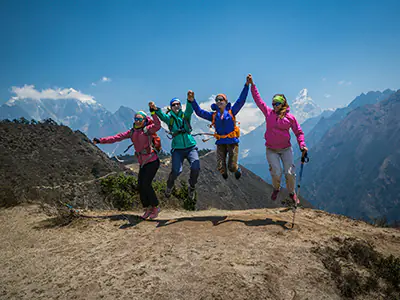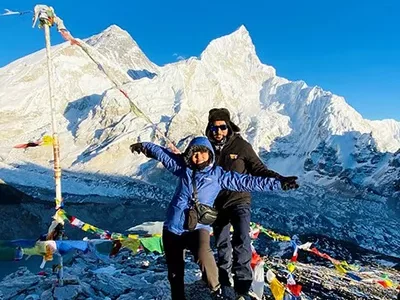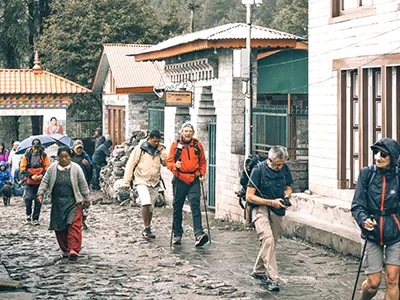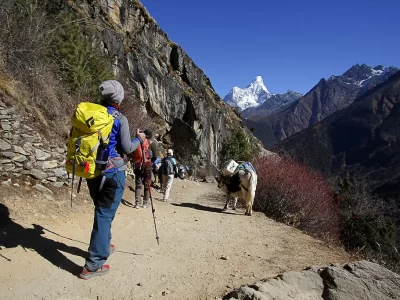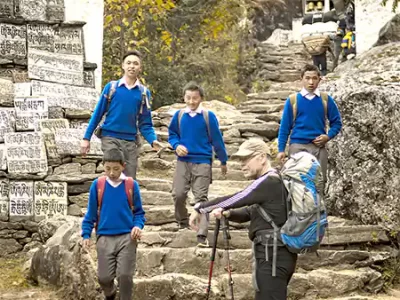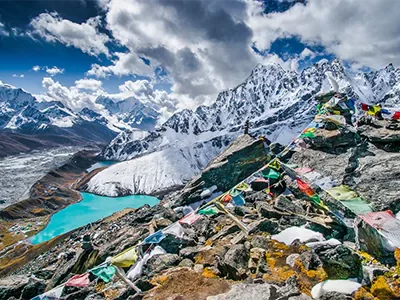Embarking on the mesmerizing Everest Base Camp Trek in July is an extraordinary adventure that combines the allure of the world’s highest peak with the enchantment of the monsoon season. Trekking to Everest Base Camp offers a unique opportunity to witness the Khumbu Valley in its most vibrant and captivating form. This blog post will explore the awe-inspiring experience of conquering the Himalayas through the Everest Base Camp trek in July, providing essential insights, preparation tips, and unforgettable moments.
As one of the most renowned treks in the world, the Everest Base Camp trail weaves through awe-inspiring landscapes, ancient Sherpa villages, and challenging mountain terrain. July, traditionally considered the monsoon season in Nepal, adds a distinct charm to this epic adventure. While many trekkers opt for the drier seasons, the allure of trekking to Everest Base Camp in July lies in the unparalleled beauty that emerges as the monsoon breathes life into the mountains.
The lush greenery blankets the valleys adorned with blooming rhododendrons and cascading waterfalls. It’s a time of natural abundance and breathtaking vistas that create an extraordinary backdrop for your journey to Everest Base Camp. This unique season allows trekkers to witness the Khumbu region in its full glory, surrounded by vibrant colors and serene landscapes.
Trekking in July presents its own set of challenges and rewards. The weather can change rapidly; sudden showers and cloud cover might reduce visibility. However, the reduced number of trekkers during this season allows for a more intimate and serene experience amidst the grandeur of the Himalayas. It’s a great way to spend time alone in nature and experience the peace of the mountains.
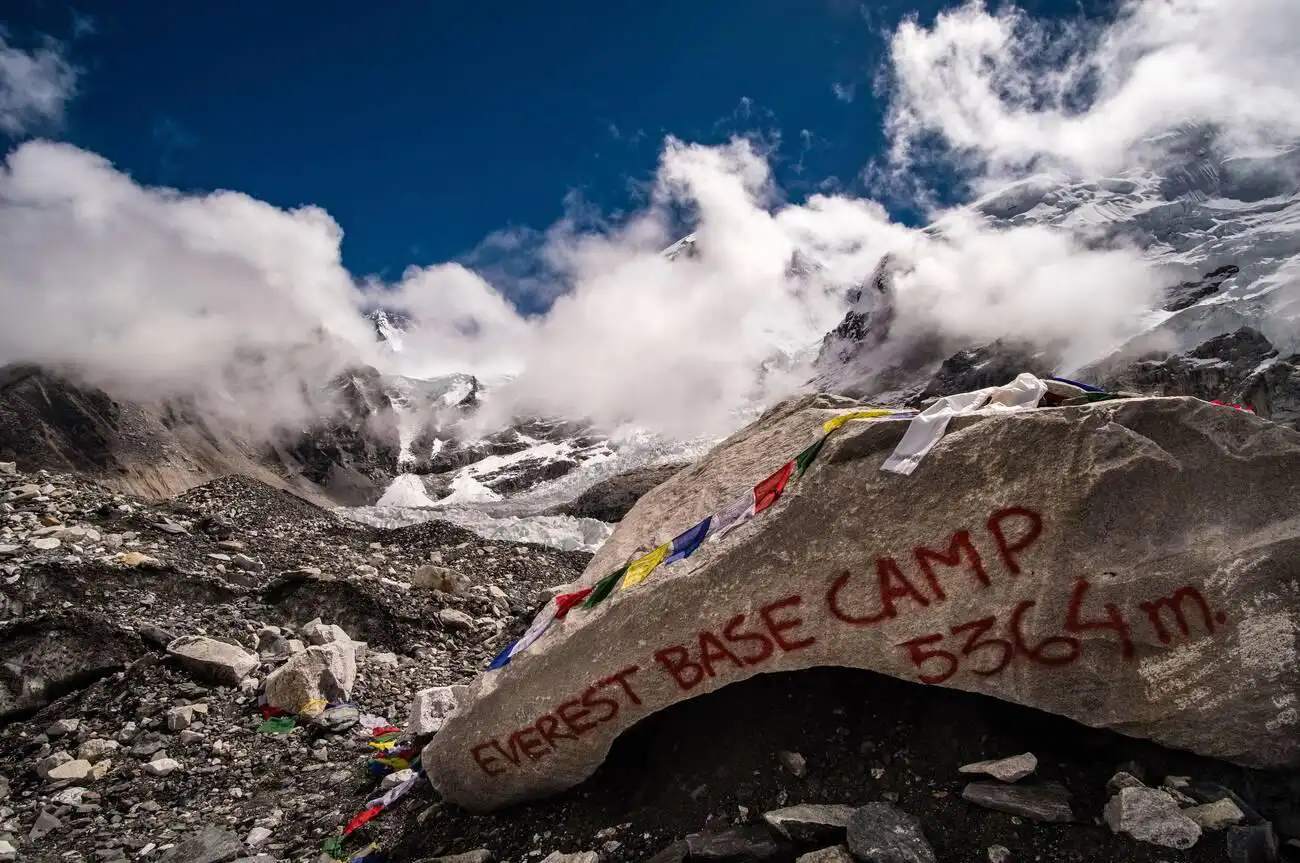
Physical fitness is crucial to conquering the demanding terrain and high altitude. To ensure a safe and enjoyable journey, it is essential to include a well-rounded training regimen that encompasses aerobic activities, strength training, and proper acclimatization procedures. Additionally, packing the right gear is essential to tackle the occasional showers and maintain comfort throughout the journey.
Embarking on the Everest Base Camp trek in July is not just a physical adventure; it’s a personal conquest and an opportunity for self-discovery. It pushes the boundaries of your endurance and determination, leaving you with a profound sense of accomplishment upon reaching the base camp. Your recollections of the Himalayas will always be tinged with the friendships you formed on the trail. This blog series will detail the exciting journey to Everest Base Camp in July.
From detailed itineraries to practical tips and inspiring stories, we will equip you with the knowledge and inspiration to undertake this remarkable adventure. Put on your hiking boots, channel your inner mountain man, and come with us in July on our epic journey to the top of the Himalayas.
Why Trek to Everest Base Camp in July?
Weather conditions and climate: July falls during the monsoon season in Nepal, bringing lush greenery, clear skies, and moderate temperatures. This unique season offers trekkers a distinct and captivating experience amidst the grandeur of the Himalayas. Here are some compelling reasons why trekking to Everest Base Camp in July can be an unforgettable adventure:
Lush greenery and blooming landscapes: The monsoon season brings abundant rainfall to the Khumbu region, transforming the valleys into vibrant and picturesque havens. The once-dry terrain becomes adorned with lush green forests, colorful rhododendron blooms, and glistening waterfalls. Trekking during this time offers an opportunity to witness the region’s natural beauty in full bloom, creating a breathtaking backdrop for your journey.
Reduced crowds and a peaceful ambiance: Compared to the peak trekking seasons of spring and autumn, July sees fewer trekkers on the trail. This means you can enjoy a more intimate and serene experience, with less congestion on the trails and at tea houses along the route. The quieter atmosphere allows you to immerse yourself fully in the tranquility of the mountains, fostering a deeper connection with nature and a sense of solitude.
Clear skies and panoramic views: While the monsoon season brings occasional rain showers, it also offers periods of clear skies and stunning vistas. The rain typically washes away the haze, revealing a pristine panorama of the Himalayas, including the towering summit of Mount Everest. The dramatic play of light and shadow on the mountains adds a touch of magic to the landscape, creating postcard-worthy moments at every turn.
Moderate temperatures and comfortable trekking conditions: July brings moderate temperatures to the region, making it more pleasant for trekking. The days are usually mild and enjoyable, with average daytime temperatures ranging from 10°C to 20°C (50°F to 68°F) at lower elevations. The cooler temperatures create comfortable conditions for trekking, allowing you to enjoy the journey without excessive heat or cold.
Cultural experiences and interactions: Despite being a quieter season, July still provides opportunities for cultural immersion along the trek. You can engage with the local Sherpa communities, visit monasteries, and witness their unique way of life. The reduced crowds also mean more time and space for meaningful interactions with the locals, gaining insights into their traditions, beliefs, and hospitality.
While trekking to Everest Base Camp in July has advantages, it’s essential to be prepared for the challenges this season brings. It rains occasionally, and the clouds often block the sun, so plan accordingly. Packaging appropriate rain gear, waterproofing your belongings, and being flexible with your itinerary are essential. The trails can also become slippery and muddy, requiring extra caution while trekking.
Trekking to Everest Base Camp in July offers a remarkable and distinct experience amidst the monsoon season’s lush greenery and natural beauty. The reduced crowds, clear skies, and moderate temperatures make it an enticing time to conquer the Himalayas, creating memories that will last a lifetime. So, embrace the allure of the monsoon and embark on this extraordinary Everest Base Camp Trek in July.
Everest Base Camp Trek for Beginners
Everest Base Camp Trek
Luxury Everest Base Camp Trek
Preparing for the Journey
Everest Base Camp Trek in July requires careful preparation to ensure a safe and enjoyable experience. Here are two key aspects to focus on when preparing for this epic journey:
Training and physical fitness
Prioritizing physical fitness is essential for surviving the Everest Base Camp trek’s challenging terrain and high altitude. Here are some essential considerations:
a. Cardiovascular training: To strengthen your heart and lungs, you should regularly participate in aerobic activities like jogging, cycling, or swimming. Aim for activities that elevate your heart rate and help you build stamina for long days of trekking.
b. Strength exercises: Incorporate strength training exercises into your fitness regimen to build muscular strength and endurance. Focus on exercises that target your lower body, core, and back, as these muscle groups play a vital role in trekking on uneven terrains and carrying a backpack.
c. Acclimatization techniques: Acclimatizing correctly to the high altitude is crucial for your safety and well-being during the trek. It would help if you gradually increased your ascent to prepare your body for the lower oxygen levels at higher altitudes. I think you should consider including acclimatization days in your itinerary to help in the adjustment process.
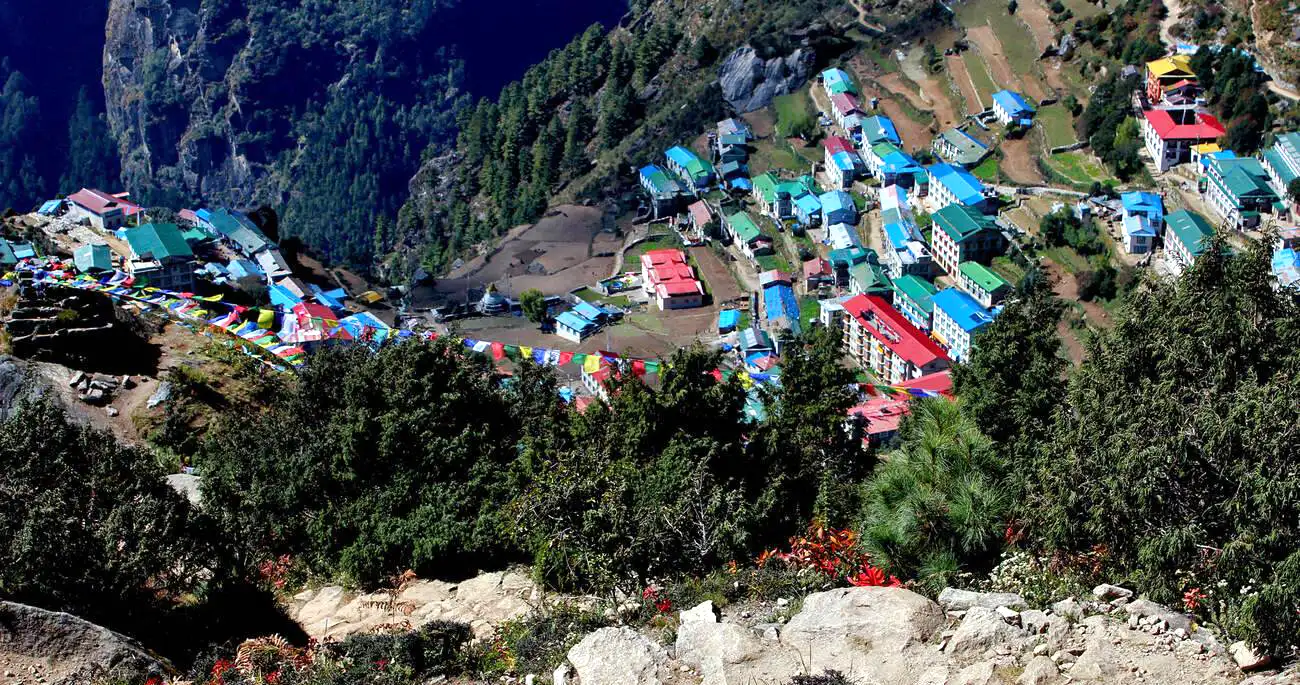
Packing essentials
Bringing along the correct supplies will make your hike more pleasant and secure. Here’s a comprehensive packing list for a successful Everest Base Camp trek in July:
a. Clothing: Layering is essential to adapt to changing temperatures. Pack moisture-wicking and quick-drying base layers, insulating mid-layers, a windproof and waterproof outer shell, and thermal or fleece jackets for colder days. Remember to pack a warm hat, gloves, and a buff or scarf for protection against chilly winds.
b. Footwear: Get a pair of high-quality, waterproof, ankle-supportive hiking boots. Ensure they are well broken in before the trek to prevent blisters. Pack comfortable and moisture-wicking hiking socks to keep your feet dry and blister-free.
c. Backpack: Choose a sturdy and comfortable backpack with sufficient capacity to carry your essentials. Opt for a backpack with adjustable straps and a waist belt for better weight distribution and support during long hikes.
d. Rain gear: Given the occasional showers during the monsoon season, waterproof and breathable gear is essential. Make sure your gear stays dry by bringing a raincoat, rain trousers, and a backpack cover.
e. Trekking essentials: Include a good-quality sleeping bag suitable for cold temperatures, a headlamp with extra batteries, a refillable water bottle or hydration bladder, a trekking pole for stability, sunscreen with high SPF, sunglasses with UV protection, and a first aid kit.
Remember to pack light and only bring essential items. Pack as little and efficiently as possible to save unnecessary stress on your body when hiking.
By focusing on your physical fitness and packing the right essentials, you’ll be well-prepared to tackle the challenges and fully embrace the breathtaking journey to Everest Base Camp in July.
The Route and Highlights
Embarking on the Everest Base Camp trek in July takes you on a remarkable journey through stunning landscapes, vibrant Sherpa villages, and cultural landmarks. Let’s explore the route daily, highlighting the significant stops and breathtaking highlights.
Day-by-day itinerary
Lukla to Phakding: After a scenic flight from Kathmandu to Lukla, the trek begins with a descent towards the Dudh Koshi River. You’ll pass through charming Sherpa villages and lush forests, eventually reaching Phakding, where you can rest and acclimatize.
Phakding to Namche Bazaar: Following the Dudh Koshi River, hikers will encounter suspension bridges and rise through pine trees. Namche Bazaar is a lively Sherpa settlement and a vital acclimatization stop after a long, steep ascent. Experience the local culture and food while gazing at Everest and the other majestic mountains.
Acclimatization Day in Namche Bazaar: Stay at Namche Bazaar for an extra day to become acclimated. The views of Everest, Lhotse, and Ama Dablam from the Everest View Hotel are well worth the short climb up to the hotel. Visit the Sherpa Cultural Museum to learn more about the history and customs of the area.
Namche Bazaar to Tengboche: The trail ascends through rhododendron forests, offering glimpses of Everest and other towering peaks. Trekking further, you’ll reach Tengboche, home to the famous Tengboche Monastery. Marvel at the intricately decorated monastery, attend morning prayers, and soak in the serene atmosphere.
Tengboche to Dingboche: Journeying through forests and crossing suspension bridges, you’ll go to Dingboche. This picturesque village is surrounded by stunning landscapes, with views of Ama Dablam and other snow-capped peaks. Enjoy the peacefulness of the Himalayas and acclimatize to the increasing altitude.
Acclimatization Day in Dingboche: Another acclimatization day is scheduled in Dingboche to help your body adjust to the higher altitude. Hike to Nangkartshang Peak for stunning panoramas of the Everest range and surrounding mountains.
Dingboche to Lobuche: Trekking along the moraine of the Khumbu Glacier, the trail gradually ascends towards Lobuche. The terrain becomes more harsh and dramatic as you ascend in height. Enjoy panoramic views of Nuptse, Pumori, and other Himalayan giants.
Lobuche to Gorak Shep and Everest Base Camp: The next stop is the little village of Gorak Shep, located at the base of Kala Patthar. Starting from Gorak Shep, the trek to Everest Base Camp is strenuous but ultimately rewarding. Experience the excitement and achievement of reaching the base camp, surrounded by the towering peaks and the bustling activity of mountaineers preparing for their ascent.
Gorak Shep to Kala Patthar and back to Pheriche: Wake up early to hike to the summit of Kala Patthar, a renowned viewpoint offering unparalleled panoramic views of Everest, Lhotse, and the surrounding Himalayan range. Return to Gorak Shep and continue the trek to Pheriche, where you can rest and rejuvenate.
Pheriche to Namche Bazaar: Retrace your steps back towards Namche Bazaar, enjoying the familiar landscapes and reflecting on your incredible journey.
Namche Bazaar to Lukla: The trek’s final leg takes you back to Lukla, where you’ll bid farewell to the mountains and celebrate your accomplishment.
Namche Bazaar
Namche Bazaar is a bustling Sherpa town that welcomes visitors to the Everest area with its distinct culture. Explore the narrow streets with colorful shops, markets, and tea houses. Spend time with welcoming locals and gain insight into the customs and history of the Sherpa people. From Namche Bazaar, the views of Everest, Lhotse, and the surrounding peaks are awe-inspiring, providing a glimpse of the majestic beauty that awaits you.
Tengboche Monastery
Tengboche Monastery, perched on a hilltop amidst stunning mountain vistas, holds great spiritual and cultural significance. The monastery serves as a focal point for religious activities in the Khumbu region and is the largest. Attend morning prayers, witness the monks’ chanting, and soak in the peaceful ambiance. The monastery’s intricate architecture and the panoramic views of Everest, Ama Dablam, and other peaks create an enchanting experience.
As you trek through these great locations, you’ll witness the unparalleled beauty of the Everest region, forge connections with the Sherpa people, and immerse yourself in the spiritual and cultural heritage of the Himalayas. The Everest Base Camp trek in July offers an extraordinary blend of natural wonders and cultural exploration, leaving you with memories that will last a lifetime.
Everest Base Camp Short Trek
Everest Panorama Trek
Gokyo Cho La Pass Trek
Challenges and Rewards
Trekking to Everest Base Camp in July brings its own set of challenges and rewards. Let’s explore some of the critical aspects to consider:
Weather considerations
Trekking during the monsoon season in July means encountering weather conditions that can be both challenging and rewarding. Here are some essential factors to keep in mind:
a. Rain and cloud cover: July is characterized by occasional rain showers and cloud cover in the Everest region. This can affect visibility and obstruct panoramic views of the mountains. You should always be ready for rain by carrying rain gear such as a rain jacket, rain trousers, and a backpack cover. Embrace the rain as part of the adventure and appreciate the unique atmosphere it creates.
b. Implications: Visibility can be reduced by cloud cover and mist, especially at higher elevations. However, the rain showers often clear the air, providing crisp and breathtaking views of the surrounding peaks. Be patient and take advantage of the breaks in the weather to witness the majestic Himalayan panorama.
c. Trail conditions: The monsoon season brings occasional landslides and muddy sections along the trail. It’s essential to exercise caution, especially on steep and slippery sections. Trekking poles can provide stability and help you navigate through challenging terrain.
Personal achievements
Completing the Everest Base Camp trek in July is a significant personal accomplishment. Here are some rewarding aspects of the journey:
a. Stunning panoramic views: Despite the occasional weather challenges, the moments when the clouds part and reveal the towering peaks of Everest, Lhotse, and other Himalayan giants are genuinely awe-inspiring. These breathtaking views become even more rewarding after enduring weather-related hurdles.
b. Sense of accomplishment: Reaching Everest Base Camp is a testament to your determination, physical endurance, and mental strength. It’s a milestone that brings a profound sense of achievement and satisfaction. The feeling you get when standing at the foot of the tallest peak on Earth is hard to describe.
c. Camaraderie and shared experiences: The EBC trek attracts adventurers worldwide, creating a vibrant community of fellow trekkers. Along the journey, you’ll meet like-minded individuals with the same passion for exploration. The shared challenges, triumphs, and camaraderie formed during the trek foster lifelong friendships and create lasting memories.
Personal stories and anecdotes from those who completed the Everest Base Camp trek in July highlight the transformative nature of this adventure. Each trekker has unique experiences and insights, discovering inner strength, resilience, and a deeper connection with nature.

Safety and Responsible Trekking:
Safety and responsible trekking are paramount in the Everest Base Camp trek in July. Here are two key aspects to consider:
Altitude sickness
Traveling to higher altitudes, altitudes, or acute mountain sickness (AMS) is a prevalent worry. Please be sure to learn about the risks and take the necessary precautions to ensure a safe trekking experience. Here’s what you need to know:
a. Recognizing symptoms: Familiarize yourself with the symptoms of altitude sickness, which include headache, dizziness, nausea, loss of appetite, and fatigue. Please let your guide or fellow hikers know immediately if you feel pain or discomfort.
b. Acclimatization: Acclimatization is crucial to mitigate the risk of altitude sickness. Include rest days and gentle ascents to let your body acclimate to the higher altitude. Do as your guide tells you and get acclimated to the altitude.
c. Hydration and nutrition: Staying hydrated and well-nourished is essential to prevent altitude sickness. Monitor your water, carbohydrate, and protein intake throughout the day. Limit your intake of alcoholic and caffeinated drinks, as they both have a drying effect on the body.
d. Medication: Consult a medical professional before your trek and consider taking altitude sickness medication such as acetazolamide. However, medication should not be used as a substitute for proper acclimatization and should only be taken under medical supervision.
Responsible tourism
Responsible trekking practices are vital to preserve the natural beauty of the Everest region and respect the local culture. Here’s how you can contribute to responsible tourism:
a. Eco-friendly habits: Minimize your environmental impact by practicing eco-friendly habits. Bring a refillable container and some water purification tablets to reduce the waste of single-use plastic water bottles. Properly dispose of waste in designated bins or take it back with you. Respect wildlife and natural habitats by observing from a distance and refraining from littering.
b. Cultural sensitivity: The Sherpas are only one of several indigenous peoples that make their home in the Everest area. Honor their cultural practices and sacred locations. Dress respectfully, get permission before taking photos of locals, and try to have meaningful discussions with the people you meet.
c. Leave no trace: Leave the natural environment as you found it. Avoid defacing rocks or trees, and refrain from taking natural souvenirs such as plants, flowers, or rocks. Follow the paths that have been established, and refrain from taking any detours that might damage the ecology.
d. Support local communities: Contribute to the local economy by staying in locally-owned tea houses, purchasing local products, and hiring local guides and porters. Respect their expertise and cultural knowledge, and engage in responsible and fair negotiations.
e. Sustainable tourism initiatives: Be aware of and support sustainable tourism initiatives that protect the Everest region’s fragile ecosystem. These initiatives include waste management projects, reforestation efforts, and educational programs for local communities and trekkers.
By prioritizing safety and practicing responsible trekking, you ensure your well-being and contribute to preserving the Everest region’s natural and cultural heritage. Remember, responsible trekking is a collective effort that requires the participation and commitment of all trekkers to maintain the beauty and integrity of this extraordinary destination.
Conclusion
Embarking on the Everest Base Camp trek in July offers a unique and awe-inspiring adventure amidst the lush Himalayan landscapes. Despite the challenges posed by the monsoon season, the rewards of witnessing the breathtaking beauty of the Khumbu region and setting foot near the iconic Everest Base Camp are immeasurable.
Trekking in July allows you to experience the region in its full bloom, with vibrant greenery and clear skies. The reduced crowds provide a sense of tranquility and allow you to immerse yourself fully in the natural wonders surrounding you. The occasional rain showers and cloud cover may test your resilience, but they add an element of adventure and create a unique atmosphere exclusive to this time of year.
The journey to Everest Base Camp in July requires careful preparation, including physical fitness training, appropriate gear, and an understanding of altitude sickness and acclimatization. By adhering to responsible trekking practices, you can ensure your safety, minimize your environmental impact, and show respect for the local culture and communities.
So gear up, prepare well, and embrace the incredible journey that awaits you on this remarkable trek in July. It will push your limits, reward you with stunning panoramic views, and leave you with a sense of accomplishment that words cannot adequately express. What you learned and experienced on this journey will be with you forever. You can make a moment to embark on this epic journey and let the magic of the Everest Base Camp trek in July unfold before your eyes.

